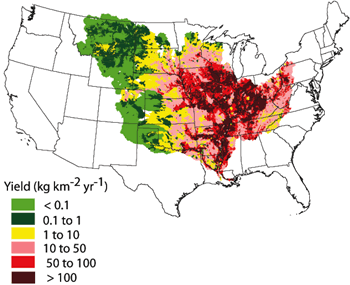The researchers are predicting the area could measure a record 8,800 square miles, or roughly the size of New Jersey. In 2007, the dead zone was 7,903 square miles. The largest dead zone on record was in 2002, when it measured 8,481 square miles.
Flooding on the Mississippi River is leading to significant increases in nitrogen within the Mississippi and Atchafalaya Rivers.
The dead zone is an area in the Gulf of Mexico where seasonal oxygen levels drop too low to support most life in bottom and near-bottom waters. This low oxygen, or hypoxic, area is primarily caused by high nutrient levels, which stimulates an overgrowth of algae that sinks and decomposes. The decomposition process in turn depletes dissolved oxygen in the water. The dead zone is of particular concern because it threatens valuable commercial and recreational Gulf fisheries.
Below are graphics from USGS. USGS also has data depicting monthly nutrient and streamflow delivery to the gulf (Previous years).



USGS also has a study investigating Phosphorus and Nitrogen delivery into the Gulf.



No comments:
Post a Comment